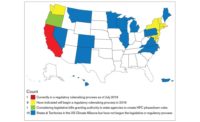The acceptance and use of A2L refrigerants in HVACR equipment paves a complicated path that boasts more twists and turns than a cheap garden hose. Here’s a brief update on what’s coming down the pipeline.
Here in a SNAP
A2Ls are attractive because of their lower flammability ratings. However, before such alternative refrigerants can be used in the U.S., they must be listed and identified as acceptable under the Environmental Protection Agency’s (EPA’s) Significant New Alternatives Policy (SNAP) program. In May, the EPA prepublished the latest chapter in this saga, SNAP Rule 23, which proposed the use of several A2L refrigerants, including R-32, R-452B, R-454A, R-454B, R-454C, and R-457A, in new light commercial air conditioners and heat pumps.
Once alternate refrigerants are SNAP-approved, safety standards must be adopted into state or local building codes or approved by an authority having jurisdiction. These standards are often adopted into model building codes, which can take around two years to develop.
Two such standards, UL 60335-2-40 (the product standard) and ASHRAE 15 (the application standard), were most recently updated in 2019. Governing code organizations, the International Association of Plumbers and Mechanical Officials (IAPMO) and International Code Council (ICC), failed to adopt the 2019 versions of both standards because of their limited use of low-GWP refrigerants in specific applications. The next opportunity to widely enable low-GWP refrigerants will occur in the 2024 updates of each standard.
While select A2Ls have been approved in air conditioners and heat pumps, they have not been authorized for use in commercial refrigeration applications, as commercial refrigeration safety standards are still being developed, complicating matters further.
SNAP Rule 23 also (strangely enough) omits the use of A2L refrigerants in chiller systems. In lieu of this, 15 U.S. states have opted to develop SNAP Rule 21, which will allow the use of A2Ls in chillers starting in 2024.
Knowledge Is Power
There’s a lot to digest here — and we’ve yet to touch on training, flammability, blends, leakage, efficiency, and more.
Engineered Systems offers numerous resources on the topic, including the articles that appear on Page 48 of this issue; Page 30 of the September 2020 issue; and this feature, written by Joanna Turpin.
Valuable information is available from RSES, AHRI, the ACHR NEWS, various refrigerant manufacturers, and more. Don’t be afraid to dive into the topic.
Stay informed to ensure you’re positioned for future success in the ever-changing, quickly adapting HVAC refrigeration landscape.





